Island of Hope
In a remote village in Fiji, nature and people are working together to save each other
By Emily Sohn
A pod of dolphins play in the bay as we hop off a small motorboat into knee-deep water. Back home, it is Thanksgiving, cold and gray, but here in Fiji, the air is windless and steamy. This country of tropical islands speckles the Pacific Ocean near the equator, several hours by plane from Australia and New Zealand.
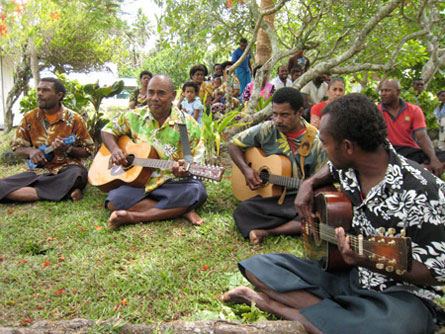
A shy teenager named Lena greets me with a necklace made of flowers. She hands me a coconut with its top cut off so I can drink the juice. As my own family feasts on turkey and stuffing 5,500 miles away, I squint against the hazy sun and notice all the things that Kiobo (pronounced Kee-OHM-bo) doesn’t have.
There is no running water. There are no power lines, no electricity, no stores. I don’t see any TVs, computers or video games. Many of the villagers are wearing clothes they made themselves.
For the people of Kiobo, life today is much like it was for their ancestors. They eat the vegetables they grow, the coconuts they pick and the fish they can catch from the sea that surrounds them.
“Everything we get is from the ocean,” says Sirilio Didi Dulunaqio, 39, who grew up in the area and now works for two conservation organizations, the Coral Reef Alliance and the Wildlife Conservation Society. “We eat almost everything out there.”
In recent generations, however, living off the sea has become more challenging. Around Fiji, as in oceans around the world, underwater creatures are in major trouble. Pollution, climate change and tourism threaten their survival. Huge boats scoop massive numbers of fish, lobsters and clams out of the water. The animals can’t multiply fast enough to keep up.
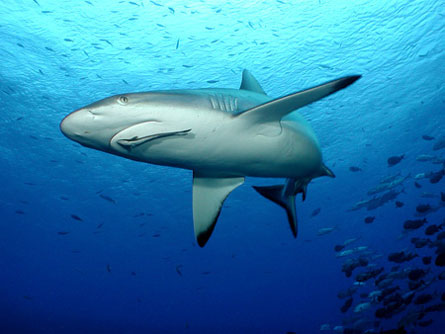
For the villagers, our visit was an important first step toward having it all. Here’s their vision: By luring tourists to visit the area, the Kubalau hopes to bring in more money. In turn, the villagers plan to use those tourist dollars to protect the underwater environment, the fish and their local traditions.
For me, a journalist accompanying the tour group, the visit was a chance to see how nature and people are working together to save each other. After all, what a bunch of remote villagers are doing in Fiji might hold lessons for threatened people, places and animals all over the world.
“Fiji,” says Les Kaufman, a marine ecologist and conservation biologist at Boston University, “could be a beacon to the world.”
Taking stock
I arrived in Fiji five days earlier — at 5 a.m. on the Saturday before Thanksgiving. Within hours, I was swaying on a 120-foot-long boat called the Nai’a. Scientists often use the ship on research expeditions. It has a kitchen and dining area in the center, cozy living quarters down below, and a deck full of scuba tanks.
Waves of nausea sweep through me every time the boat rocks one way, then the other. Trying to ignore the seasickness, I yank on a full-body wetsuit. Next come booties, a thick black hood, and a Neoprene vest. Fiji is a warm and tropical place, but it’s cold where I’m going: 80 feet underwater.
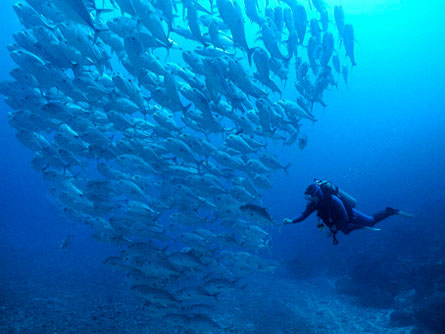
Marine reserves are like national parks of the sea. Only certain activities are allowed. For instance, in Yellowstone National Park (located mainly in Wyoming) and the Grand Canyon National Park (in Arizona), people can’t cut down trees or hunt for animals. Here at Namena, huge boats aren’t allowed to take any fish, although the locals are still allowed to catch fish for the sake of survival.
At Namena, conservation is about people as much as it is about fish. According to long-respected custom, the people of the Kubalau own these waters as part of their traditional fishing grounds, called Qoliqoli (n-GO-li-GO-li).
In the next five years, the goal is for the locals to take charge of the area without the help of any conservation organization. They’ll make sure that people use the land and water in a way that the environment can handle, says Rick MacPherson, CORAL’s conservation programs director.
With that aim in mind, villagers are learning to manage money that comes in from tourism. They’re teaching their kids about what makes each of the Kubalau cultures distinct. They’re taking courses on how to host visitors. They’re also training fish wardens, who troll the reserve to prevent poachers from fishing illegally.
At stake are the coral reefs that lie offshore from these villages. Reefs are underwater environments that support fish, which in turn support local cultures and traditions. But reefs are under siege around the world. To stop them from disappearing, along with all the fish they support, conservation efforts must move quickly.
“There is a crisis currently facing reefs globally and locally,” MacPherson says. “There is an urgency to this story.”
Plunging under
For the first few days aboard the Nai’a, we scuba-dive outside the Namena reserve. Even there, I feel like I’m swimming through a Dr. Seuss book: I see red fish and blue fish. There are short fish and skinny fish, long fish and fat fish, striped fish and spotted fish.
When I finally plunge into the reserve, I figure I’ll see more of the same. Within minutes, I realize how wrong I am.
At about 80 feet underwater, a flash of gray streaks by. It’s a reef shark, followed by another and then three more. Each shark’s body is longer than mine (or anyone I know).
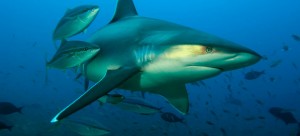
The sharks cut through huge schools of silvery fish that dart back and forth. Hundreds of dinner plate–sized fish move together like soldiers marching through streaked sunlight.
Before long, barracuda surround me. Each pointy-nosed fish is at least 6 feet long, as sleek as a bullet. I try to count them — 70, 80, maybe 100. I feel like a hamster in a running wheel made of fish. Over the next hour, I see a hammerhead shark, a hawksbill turtle, and lots and lots more fish.
In the midst of all the fins, gills and scales are mounds and ridges of corals that come in more shapes and colors than marshmallows in a box of Lucky Charms cereal. Corals in the form of purple fans mix with green brains, blue antlers and orange pillars.
Corals are microscopic animals that tend to live in tropical, sun-drenched waters, though some grow in deep waters and in cold places like Alaska. Over generations, corals band together to build complicated and fragile structures called reefs, which support a rich diversity of fish and other marine creatures.
As important as they are to fish, corals may be among the tougher animals to love. Unlike sleek sharks, playful dolphins and quirky turtles, corals just sit there. Even today, when experts know better, many people mistake corals for plants or even rocks.
Corals, however, are vital parts of healthy oceans. Reefs protect coastal towns from storm surges, and provide homes and food for fish that people eat. Corals — and the chemicals they produce naturally — might even contain medical secrets that could cure diseases.
Still, it’s the flashy fish that get the most attention, and that’s OK. Big fish, it turns out, are a key sign that a reef is doing well.
“Fish are custodians of the sea, and the big ones play very important roles,” Kaufman says. “Big predators are critical to keeping the right proportion of other animals around.”
Big fish also attract scuba divers who travel to places like Fiji to see them. At Namena, divers must pay about 13 American dollars to plunge underwater. That money goes directly to the people of the Kubalau, who use it to protect the reefs and educate their children.
Hopeful signs
The waters around the Kubalau have faced a number of threats over the years. The village elders remember a time when catching a big fish was as easy as wading into the water with a spear. In the 1980s, however, large fishing boats discovered the area. They dropped huge nets into the water and even used explosives so that dead fish would float to the surface. Reefs were destroyed in the process.
As those boats left with huge hauls of fish, the locals started to have trouble catching enough to eat. Villagers grew worried. After a while, they started to forget how easy it used to be.
“When [CORAL] first came here, we got the elders to start reminding younger people what big fish were like,” MacPherson says. “These weren’t just fish tales. They were real accounts of much larger fish than what were being caught.”
With orders from village chiefs, the Kubalau district poured its efforts into the environment. Now, studies are starting to show a rebound. The reefs are healthy and thriving. More fish and much bigger fish are inside Namena, compared with outside its boundaries.
Around the world, scientists are finding that battered reef environments can bounce back to health, if given the chance. That’s hopeful news, given the world’s many environmental woes, and how environmental destruction can affect human populations nearby.
“It’s much more important than we ever realized to take care of your back yard,” Kaufman says. ”Your back yard is your future.”
Lessons to share
With healthy reefs in their back yards, the people of the Kubalau appear to be thriving, too. During our visit to Kiobo, we take part in a traditional ceremony performed in a 25-foot-tall building made from palm trees. The villagers had just spent two weeks building the structure, called a bure (BURR-ay), by hand.
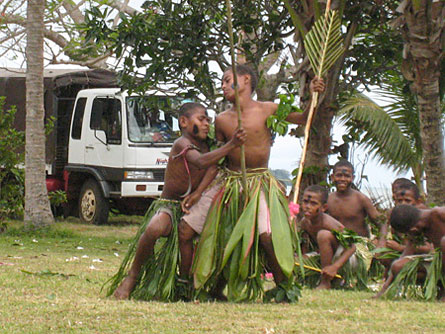
Before we wade back to our boat and launch back out to sea, I sit under a tree with the chief of a Kubalau village called Nandi. He is known as Tui Nandi, but his real name is Ratu-Peni Rasigare. A light breeze blows through the flower necklace that Lena had given me earlier in the day.
Though his native language is Fijian, Rasigare, 54, tells me in English about his childhood. He remembers playing in the water, digging in the sand, catching huge fish. The world has changed, he says, but the people of the Kubalau are determined to endure. If they can do it, experts hope, people in other parts of the world can, too.
“We are teaching small children what their real culture is,” Rasigare says. “In life, everyone has to be flexible. Even if you’re a chief, you have to be flexible.”
Kiobo is one of ten villages in Fiji&³1;s remote Kubalau district on the island of Vanua Levu (at top of SAT view), east of Wainunu Bay. The Namena Marine Reserve covers about 27 square miles and is visible in a Florida-shaped outline of reef features extending from Wainunu Bay.







